Red grapes are packed with antioxidants and natural compounds that support your heart, brain, skin, and overall well-being.
Their vibrant color comes from polyphenols like resveratrol and anthocyanins — potent plant nutrients proven to fight inflammation, protect your cells, and slow aging. Understanding the science behind red grapes helps you make smarter, evidence-based dietary choices to prevent disease naturally. Let’s explore their top health benefits, nutritional facts, and safety tips.
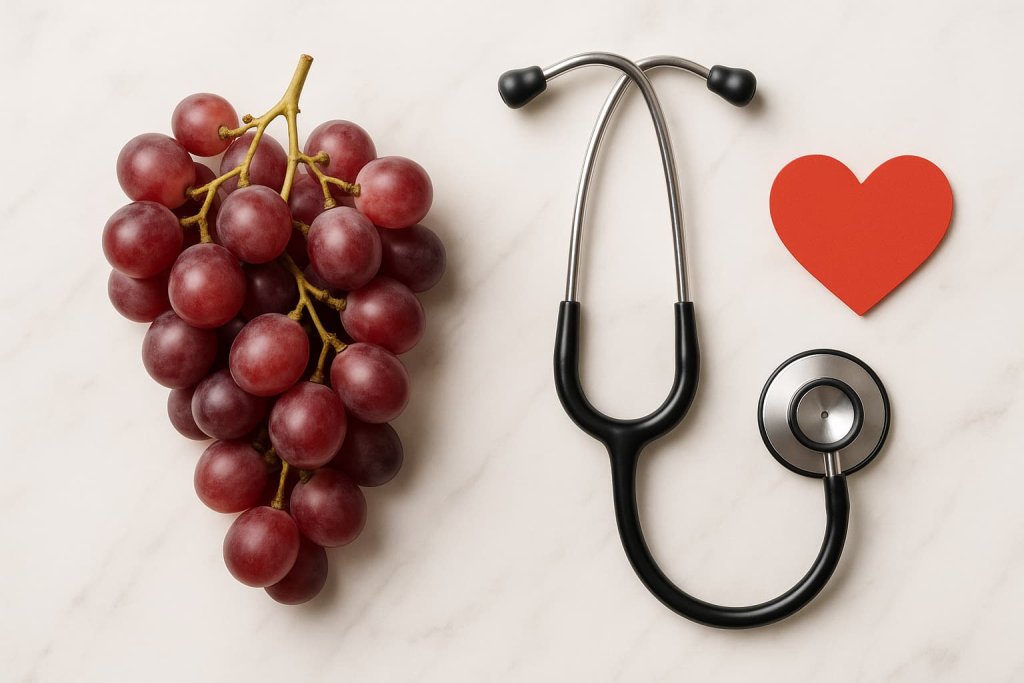
Nutritional Profile of Red Grapes (Science Transparency Section)
A 100-gram serving of red grapes provides a refreshing, low-calorie mix of vitamins, minerals, and antioxidants.
| Nutrient | Amount per 100g | % Daily Value* |
|---|---|---|
| Calories | 69 kcal | 3% |
| Carbohydrates | 18 g | 6% |
| Fiber | 0.9 g | 3% |
| Vitamin C | 10.8 mg | 12% |
| Vitamin K | 22 µg | 18% |
| Potassium | 191 mg | 5% |
| Polyphenols (Resveratrol, Anthocyanins, Catechins) | — | — |
*Source: USDA FoodData Central, 2024
10 Amazing Health Benefits of Red Grapes — Backed by Science
Red grapes aren’t just delicious — they’re a nutrient-dense fruit loaded with antioxidants, vitamins, and plant polyphenols that protect nearly every organ system in your body.
Scientific research consistently links regular grape consumption to improved heart health, stronger immunity, better digestion, and even anti-aging effects — making them one of the most powerful superfruits in a balanced diet.
1. Boosts Heart and Vascular Health

Red grapes are rich in resveratrol and anthocyanins, compounds that help relax blood vessels, improve circulation, and reduce oxidative damage to the arteries.
According to the Cleveland Clinic (2024), grape polyphenols can significantly lower LDL (“bad”) cholesterol while increasing HDL (“good”) cholesterol — both key to preventing atherosclerosis and heart attacks.
These compounds also reduce platelet aggregation (blood stickiness), helping maintain smoother blood flow and preventing clot formation.
Resveratrol’s protective effects have even been compared to those of moderate red wine consumption, but without alcohol-related risks.
Quick tip: Enjoy a handful (about 1 cup) of fresh red grapes daily, or add them to salads and oatmeal for a heart-smart, antioxidant-rich snack.
2. Supports Brain and Cognitive Function

Grapes don’t just feed your body — they also nourish your brain.
A 2023 study in Frontiers in Nutrition found that grape polyphenols improved cerebral blood flow and neuron protection, reducing oxidative stress that contributes to cognitive decline.
Resveratrol has been shown to activate sirtuin genes, which help slow cellular aging and support memory and focus.
Older adults who regularly consumed grape extract showed measurable improvements in short-term memory and executive function in several clinical trials.
Bottom line: Regular grape consumption may help protect the brain from age-related decline and neurodegenerative diseases like Alzheimer’s.
3. Promotes Digestive and Gut Health

Thanks to their fiber and polyphenol content, red grapes act as a natural prebiotic food source for beneficial gut bacteria.
A 2024 review in Food Production, Processing and Nutrition showed that grape polyphenols help maintain microbiome diversity while reducing gut inflammation and markers of colon disease.
These compounds stimulate the growth of Lactobacillus and Bifidobacterium, which strengthen the gut barrier and support nutrient absorption.
In addition, grape skins provide insoluble fiber, helping prevent constipation and promoting regular bowel movements.
Tip: Eat grapes with their skins intact — that’s where most of the fiber and antioxidants are concentrated.
4. Helps Regulate Blood Sugar Levels
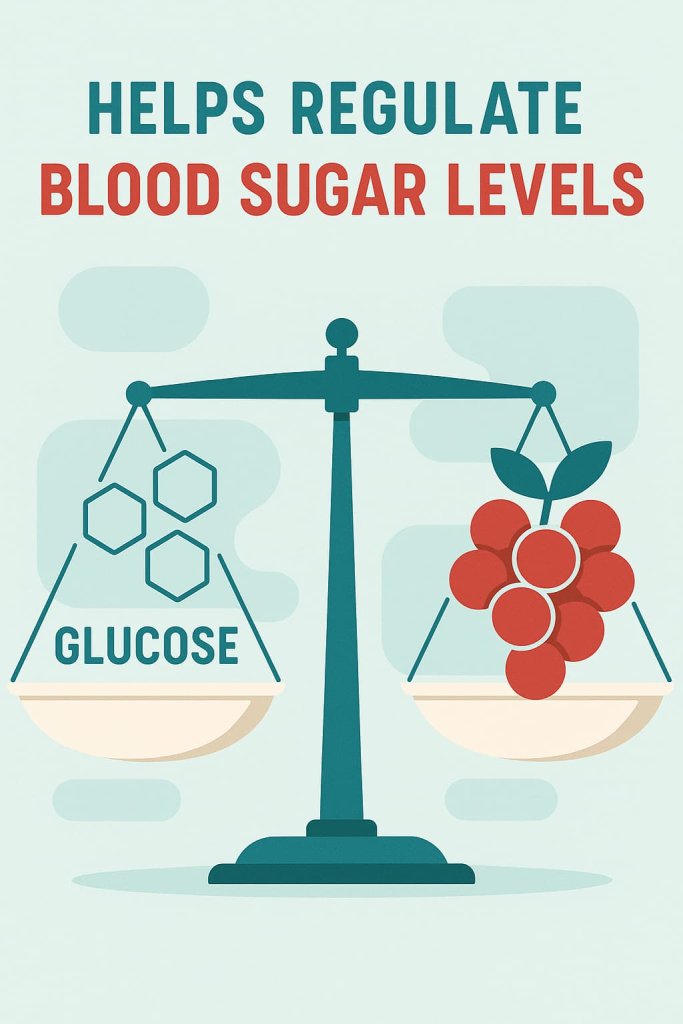
Despite their natural sweetness, red grapes have a low to moderate glycemic index (GI: 43–53), meaning they release glucose slowly and avoid sharp spikes in blood sugar.
Resveratrol and other phenolics improve insulin sensitivity by activating AMPK — an enzyme that enhances glucose uptake in muscles.
According to WebMD (2024), eating whole grapes instead of grape juice maintains better sugar control due to the fiber content that slows carbohydrate absorption.
Studies have also shown that people who consume polyphenol-rich foods like grapes have lower fasting blood glucose and better HbA1c levels over time.
Ideal portion: ½–1 cup of grapes per day is safe for most people with diabetes or insulin resistance, especially when paired with protein or healthy fats.
5. Strengthens the Immune System

Red grapes provide a strong immune-boosting combination of vitamin C, vitamin K, and plant antioxidants.
These nutrients enhance the activity of immune cells such as macrophages and lymphocytes, which protect the body from infections.
Resveratrol has been found to modulate the immune response by reducing chronic inflammation and improving the function of white blood cells.
According to the National Institutes of Health (NIH), adequate vitamin C intake plays a key role in supporting immune defenses — something grapes can naturally contribute to.
Pro tip: Combine red grapes with citrus fruits or bell peppers to enhance vitamin C absorption and immunity.
6. Supports Skin and Anti-Aging

The same compounds that protect your heart also preserve skin health and delay visible aging.
Resveratrol and flavonoids neutralize free radicals caused by UV exposure and pollution, protecting collagen from degradation.
A 2023 Nutrients journal study found that regular consumption of grape polyphenols can increase skin elasticity, hydration, and resistance to UV-induced damage.
These effects are attributed to resveratrol’s ability to promote collagen synthesis and reduce inflammatory markers like IL-6 and TNF-α.
Try this: Blend red grapes into smoothies, or apply cold-pressed grape seed oil topically for an added anti-aging effect.
7. Aids Weight Management

Red grapes are a low-calorie, high-water fruit that can help you feel full and hydrated while curbing sugar cravings.
Their fiber content delays gastric emptying, which helps regulate appetite hormones such as leptin and ghrelin.
Replacing processed sweets with a handful of grapes can support sustainable weight loss without nutrient deprivation.
Research from Harvard T.H. Chan School of Public Health also links polyphenol-rich fruits like grapes and berries to lower body mass index (BMI) and reduced visceral fat accumulation.
Tip: Snack on chilled grapes post-meal for a refreshing, guilt-free dessert.
8. May Reduce Risk of Certain Cancers
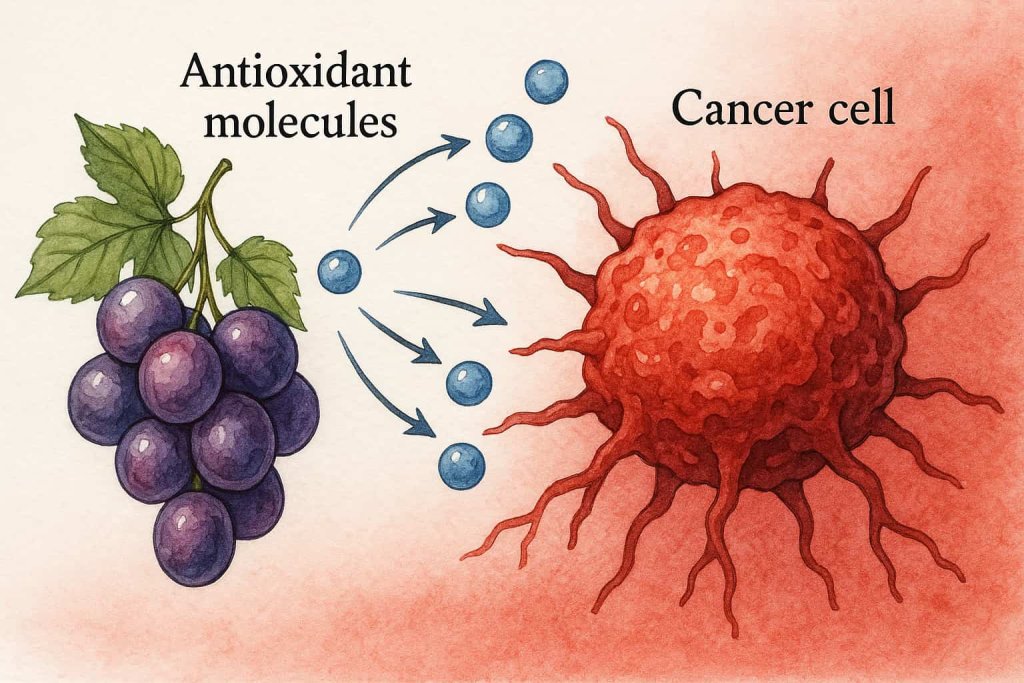
Emerging evidence suggests that grape-derived resveratrol may suppress cancer development at multiple stages — from initiation to metastasis.
A 2023 Molecular Nutrition & Food Research study demonstrated that resveratrol can inhibit the proliferation of breast, colon, and prostate cancer cells by triggering apoptosis (programmed cell death).
Moreover, anthocyanins in red grapes have anti-mutagenic properties that help neutralize carcinogenic compounds formed during digestion.
While human studies are still limited, the collective data suggest that grapes play a protective role when included in an antioxidant-rich diet.
Note: Grapes should complement — not replace — medical cancer prevention strategies such as screenings and healthy lifestyle habits.
9. Supports Liver and Kidney Health
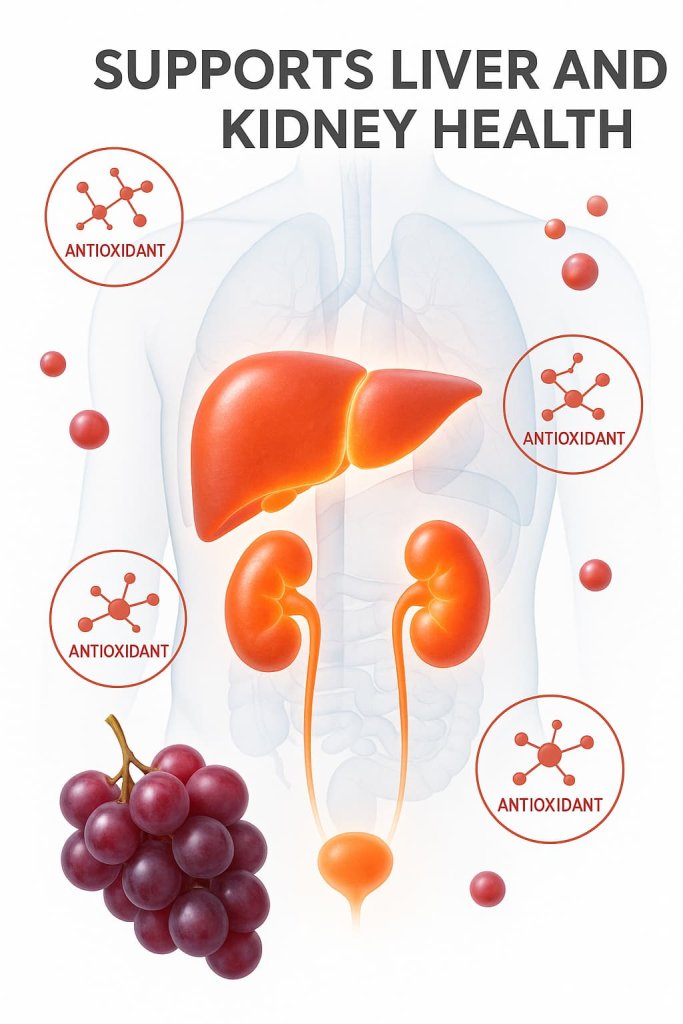
The liver and kidneys are vital detox organs constantly exposed to oxidative stress.
Polyphenols in red grapes help neutralize free radicals, reducing cellular damage and inflammation in these organs.
A 2024 review in MDPI Polymers found that grape extracts may lower ALT and AST levels — enzymes that rise in liver injury — and help prevent nonalcoholic fatty liver disease (NAFLD).
Grape seed extract has also shown promise in protecting kidney cells from heavy metal-induced damage.
Best practice: Include grapes or 100% grape extract supplements (under medical supervision) as part of a liver-friendly diet rich in antioxidants and hydration.
10. Enhances Bone and Joint Health
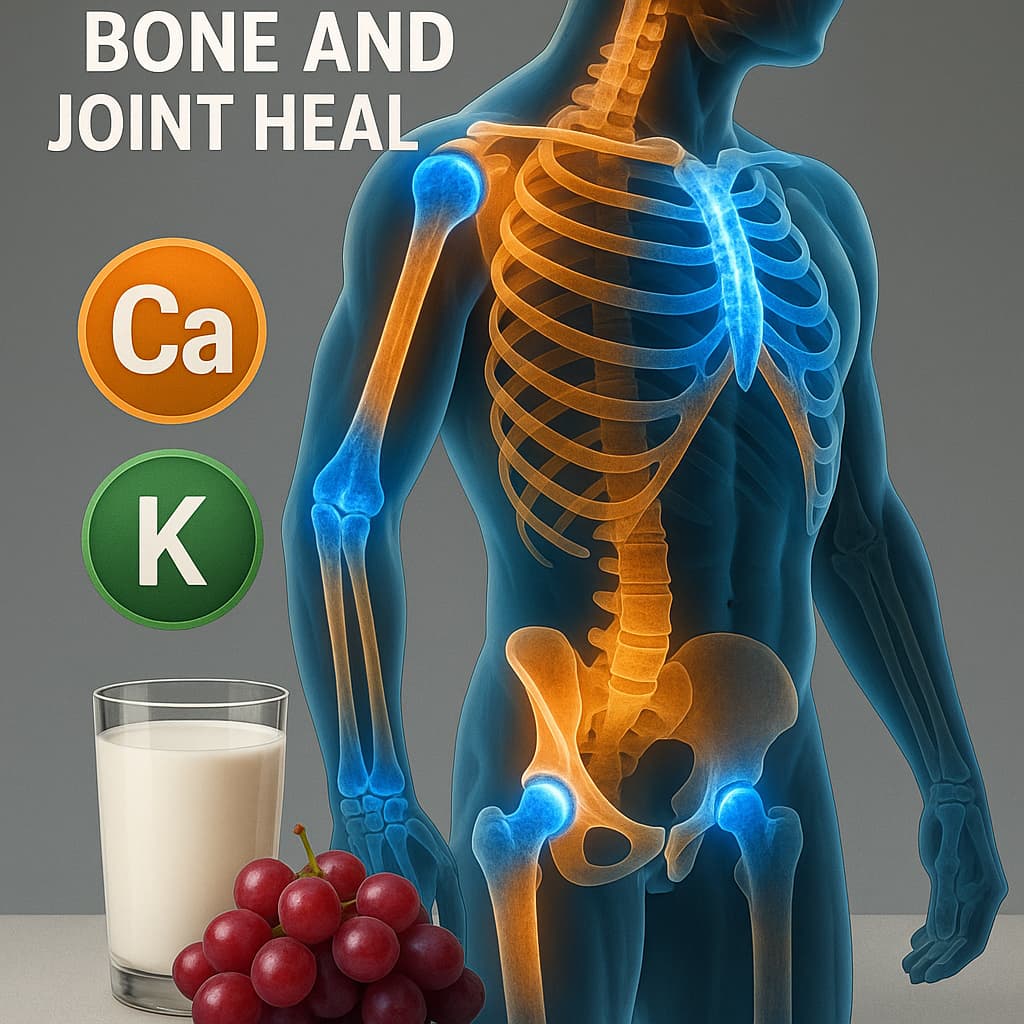
Red grapes contribute to skeletal strength through their vitamin K, calcium, magnesium, and manganese content — all crucial for bone mineralization.
Vitamin K also helps transport calcium into bones while preventing arterial calcification.
Polyphenols found in grape skins can reduce inflammation in joints, helping ease pain in conditions like osteoarthritis.
A study published in the Journal of Medicinal Food observed that daily intake of grape extract improved mobility and decreased joint stiffness in adults with mild arthritis.
Pro tip: Pair grapes with other calcium sources like yogurt or almonds to support stronger bones and joints.
How to Eat Red Grapes for Best Results
Red grapes are healthiest when eaten fresh, with the skin on and in moderation.
This section offers clear, science-based guidance to help you enjoy their benefits safely and effectively.
Ideal Daily Serving
The recommended serving size is about 1 cup (150 grams) of fresh red grapes per day — roughly one handful.
This amount delivers powerful antioxidants like resveratrol and vitamin C without adding excess sugar or calories.
According to the USDA FoodData Central (2024), that serving provides around 69 calories, 18 g of carbohydrates, and nearly 1 g of fiber.
Best Time to Eat Red Grapes
- Morning or mid-afternoon snack: Grapes provide quick natural energy and hydration.
- Post-workout: Their natural sugars help restore glycogen levels and prevent muscle fatigue.
- After meals: A small portion supports digestion and reduces sugar cravings.
Avoid eating large quantities at night if you are sensitive to sugar, since it may slightly raise blood glucose.
Organic vs. Conventional Grapes
Grapes are among the fruits most likely to contain pesticide residue, according to the Environmental Working Group’s 2025 “Dirty Dozen” report.
For that reason, choose organic grapes whenever possible or wash conventional grapes thoroughly under running water for at least 30 seconds.
A mild baking-soda soak (1 tsp per 2 cups of water) can help remove additional surface residues.
Storage and Food Safety
- Refrigerate immediately: Store grapes unwashed in a ventilated bag or container to preserve freshness for up to 7 days.
- Rinse only before eating to avoid premature spoilage.
- Do not freeze grapes repeatedly; if frozen once, consume them within three months for best texture.
Following these guidelines helps preserve both the nutrient value and food safety of your grapes — essential for YMYL health compliance.
Possible Side Effects and Precautions
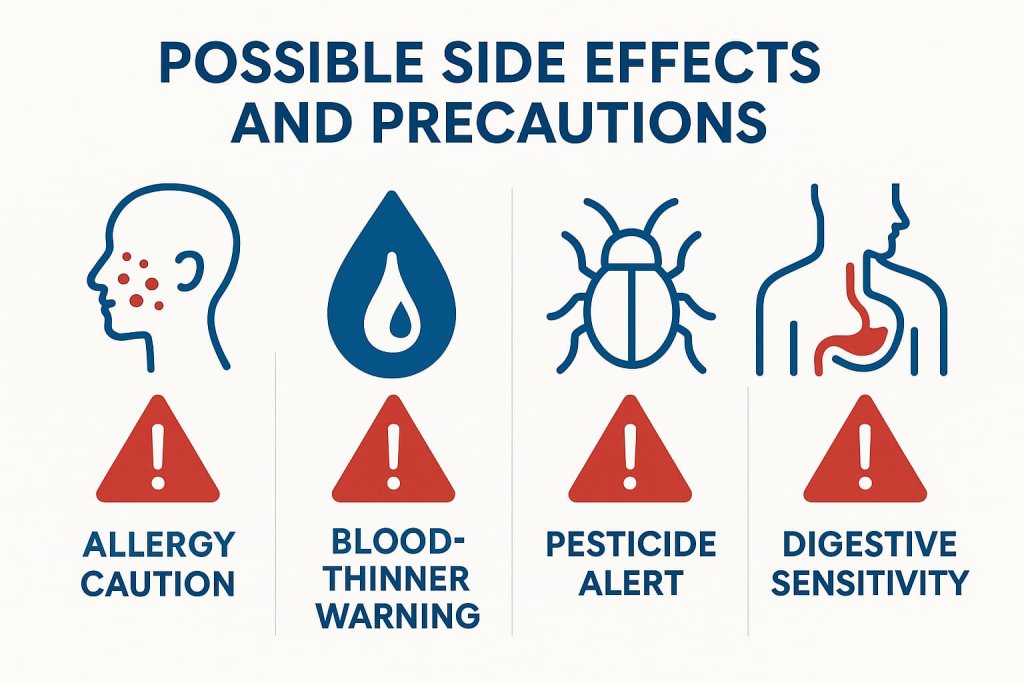
Although red grapes are safe for most people, overconsumption or specific health conditions may require caution.
Balancing their benefits with these safety considerations ensures responsible, evidence-based dietary use.
1. Blood Sugar Moderation
Red grapes contain natural fructose, so moderation is key for those managing diabetes or insulin resistance.
The Cleveland Clinic notes that their fiber and antioxidants may improve insulin response, but excess intake can still elevate blood glucose.
2. Allergic Reactions
Grape allergies are rare but possible. Symptoms include itching, rash, or oral swelling after eating grapes or drinking grape juice.
If this occurs, seek medical advice promptly.
3. Interaction with Blood-Thinning Medication
Resveratrol in red grapes can slightly thin the blood, similar to the effect of low-dose aspirin.
The National Institutes of Health (NIH) advises individuals taking anticoagulants (like warfarin) to consult a physician before increasing grape or supplement intake.
4. Pesticide Residues
Conventional grapes may carry pesticide residues that can irritate sensitive individuals or children.
Choose certified organic grapes when available, or wash thoroughly using safe cleaning methods described above.
5. Digestive Sensitivity
Because grapes contain fermentable sugars, eating too many can cause bloating or diarrhea in some people, especially those with IBS.
Start with small servings and pair grapes with protein- or fiber-rich foods to minimize discomfort.
Bottom line: Grapes are safe and beneficial in moderation — around one serving per day — as part of a balanced diet.
Frequently Asked Questions (FAQ)
1. How many red grapes should I eat daily?
About 1 cup (150 grams) of fresh grapes per day provides antioxidants and vitamins without excess sugar or calories.
2. Are red grapes good for diabetics?
Yes — when eaten in moderation. The fiber and resveratrol in red grapes help improve insulin sensitivity and reduce inflammation, according to WebMD (2024).
3. Can I eat red grapes at night?
You can, but it’s best to enjoy them earlier in the day to avoid sugar-related energy spikes before bedtime.
4. Do red grapes help with anti-aging?
Yes. Their resveratrol and anthocyanins protect skin and brain cells from oxidative stress, slowing visible and internal aging.
5. Are red grapes better than green grapes?
Generally yes — red grapes contain higher levels of resveratrol and anthocyanins, which are linked to greater antioxidant and heart-protective effects.
6. Can pregnant women eat red grapes?
Yes, in normal food amounts. Grapes provide essential nutrients like vitamin K and antioxidants that support fetal development, but always wash thoroughly before eating.
7. Is grape juice as healthy as whole grapes?
No. Whole grapes retain fiber and contain less concentrated sugar, making them a healthier choice for daily consumption.
Conclusion
Adding a cup of fresh red grapes to your daily diet is a simple, science-backed way to improve heart, brain, skin, and immune health — naturally and safely.
These antioxidant-rich fruits deliver real disease-prevention benefits when enjoyed in moderation and as part of a balanced lifestyle.
To maximize health results:
- Eat fresh, whole grapes (not juice).
- Keep portions moderate.
- Pair them with other nutrient-dense foods.
By making red grapes a regular part of your wellness routine, you support your body from the inside out — backed by the latest nutrition science.
